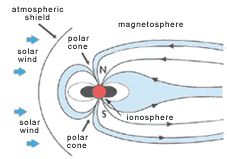|
|
|
|
The Earth's magnetic field Invisible but everywhere, a magnetic field envelopes the Earth. Apart from the effect it has on the compass, it does not really appear in our everyday lives. But outside the atmosphere, it creates a shield, the magnetosphere, that reflects cosmic particles and prevents them from reaching the ground. The simplest experiments show that a magnetic rod has an influence over the space around it, creating from its two poles, what physicists call a magnetic field. By convention, it is said that these field lines go out of the North Pole and go back in again via the South Pole. By representing a similar giant magnetic rod (dipole) placed in the centre of the Earth and inclined 11° to its axis of rotation, we can show the Earth's magnetic field (see drawing ). Although we have not yet penetrated all of its secrets, the science of magnetohydrodynamics illustrates that this phenomenon is caused mainly by the stirring effect agitating the Earth's liquid metal core at between 2,900 and 5,150 kilometres down. Recently, the study of thermoremanence (property of ferrimagnetic substances heated previously in order to create magnetism when they cool down) and the magnetising of old volcanic or sedimentary layers, has shown that over geological time, the Earth's magnetic field has varied in intensity and has switched the North and South poles countless times through the ages, thus swapping their position. As a result, there are several poles in the Antarctic, just as there are in the Arctic. The geographic poles are the two points on the Earth's surface that form each end of the Earth's axis of rotation, moving only by a few metres. The corresponding points at the output of the theoretical giant dipole's axis that we have just mentioned, are called geomagnetic poles; so they are on opposite sides of the world and located about 250 kilometres from the geographic poles. The compass points in the direction of the magnetic poles, which are the result of the convergence of dipolar and non-dipolar magnetic effects, local magnetic fields and fields created by the electrical current created by solar wind blowing in the top layers of the atmosphere. The magnetic South pole is actually some 2,800 kilometres distant from the geographic pole, off the coast of Adélie Land. |

 Based in the principle of a self-excited dynamo, these whirlpools of matter, carrying electrical current, would therefore be sufficient to generate a terrestrial magnetic field identical to the one produced by a magnet.
Based in the principle of a self-excited dynamo, these whirlpools of matter, carrying electrical current, would therefore be sufficient to generate a terrestrial magnetic field identical to the one produced by a magnet.